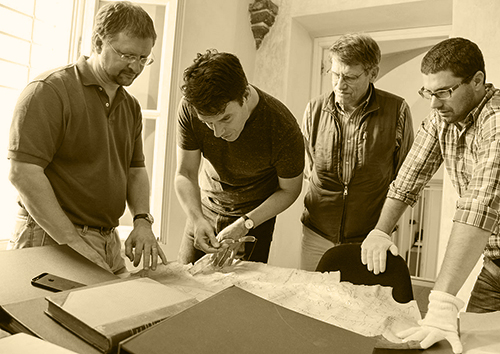Among the humanists, the paleographers and codicologists provide expert advice to scholars involved in reading manuscripts, while heraldry experts aid in identifying the coats of arms that often adorn objects.
Historians, archeologists, and historians of cartography aid with locating and deciphering unusual artifacts.
Material scientists with expertise in x-ray fluorescence (XRF), Raman spectroscopy, polarized light microscopy, and sample collection advise on the chemistry of inks, pigments, and substrates, supporting the work of humanists in the identification and provenance of objects.
Technical photographers and optical engineers help build and deploy new imaging equipment and portable supports for that equipment.
Imaging scientists help both with image processing and with the development of new methods and algorithms for image processing.
Founding Members
Gregory Heyworth ►
Director, Lazarus Project
Associate Professor of English, History and Computer Science, University of Rochester
Michael Phelps
Executive Director, Early Manuscript Electronic Library
email: mphelps@emelibrary.org
Ken Boydston
Photographer & CEO, Megavision
email: boulderhaven@yahoo.com
Roger Easton, Jr., Ph.D.
Professor of Imaging Science, Rochester Institute of Technology
Chester F. Carlson Center for Imaging Technology, Rochester Institute of Technology
email: easton@cis.rit.edu
Chet Van Duzer ►
Author & Cartographic Historian
Researcher in Residence, John Carter Brown Library, Providence, RI
email: chet.van.duzer@gmail.com
Active Lazarus Ph.D. Candidates
Catherine Albers-Morris ►
Program Coordinator
Ph.D., University of Rochester
email: calbers@ur.rochester.edu
Lazarus Lab Staff
Kathy Kingsley
Program Assistant, Lazarus Project
University of Rochester Department of English
email: kathy.kingsley@rochester.edu
Contributing Scholars
Sarah Baribeau
Brian Cook, Ph.D.
Auburn University
Auburn, AL
Multilingual medieval British literature, classical and medieval education, vernacular literacy, environmental and animal mnemonics, and media technologies
email: bsc0028@auburn.edu
Helen Davies ►
University of Colorado
Colorado Springs, CO
Multispectral imaging and mapping resources
email: hdavies@uccs.edu
Ilya Dines, Ph.D. ►
Library of Congress
Washington D.C.
Codicology, palaeography, iconography, history of the book, bestiaries
email: ilyamdemontibus@gmail.com
Kyle Ann Huskin
Center for the Study of Manuscript Cultures, Universität Hamburg
Hamburg, Germany
Image processing
email: kyle.huskin@gmail.com
Julia Josfeld
email: julia@josfeld.de
Timoty Leonardi, M.Phil. ►
Fondazione Biblioteca Capitolare di Verona
Verona, Italy
Manuscript and incunabula conservation, bookbindings, paper, enamels, metalwork
Jessica Rogers
email: jessicaRogers12@gmail.com
Sverre Tidemand
Adrian S. Wisnicki, Ph.D. ►
University of Nebraska
Lincoln, NE
Digital humanities, Victorian literature, postcolonial studies, and African studies
email: awisnicki2@unl.edu
Kevin Wittman
Ph.D. Candidate
Universidad de La Laguna
Tenerife, Spain
email: krodrigw@ull.edu.es
Alexander J. Zawacki ►
email: alexander.zawacki@gmail.com
Contributing Scientists
Joseph G. Barabe, BA ►
Barabe & Associates LLC
Oak Park, IL
Forensic science, microscopy, material analysis of art and manuscripts
email: jgbarabe@gmail.com
Damian Kasotakis
Keith Knox, Ph.D.
Airforce Research Labs (retired)
Maui, HI
Imaging processing, optics
Ira Rabin, Ph.D.
Bundesanstalt für Materialforschung und -prüfung
University of Hamburg
Berlin/Hamburg, Germany
Imaging science, material science of manuscripts and inks, x-ray fluorescence (XRF), IR spectroscopy
email: ira.rabin@bam.de


